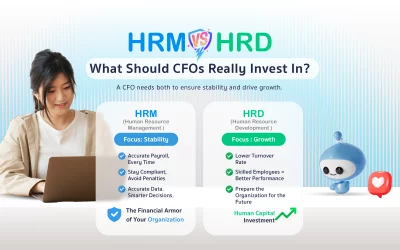Resignation of employees is a normally happened in every organization because every employee desires personal and professional growth. For any companies, they also aim to retain their employees. Especially if the employees having high skill and being specialists, the company would certainly regret for losing them.
The story of employee resignations is something that cannot be controlled or predicted. Therefore, every organization must have some plans to deal with these situations. This could involve preparing for job transfers, announcing new job for replacement and new recruitments. However, if the situation turns out to be worse than expected, which would undoubtedly become a nightmare for both the management and the HR department.
So, “How to stop the great resignation!” may become big topics to discuss.
The most popular reasons for employee resignations are:
- Tyrannical Boss: This is a classic and timeless reason encountered in every organization. Having an unsupportive or oppressive boss creates work-related stress and hinders employees from reaching their full potential. Hence, they seek a work environment where they can find a better fit with their own working style.
- Burnout: Sometimes, staying in the same job for many years can turn it into a comfort zone, leading to burnout without even realizing it. The monotonous routine and repetitive tasks push some employees to seek new challenges and environments elsewhere.
- Mismatched Organizational Culture: Every society has its rules and regulations to maintain order, but not everyone may feel comfortable within a highly structured and rigid environment. Some employees may find it difficult to tolerate the strictness of a company, including unsatisfactory benefits, leading them to seek alternatives.
- Stagnant Job Growth Working for several years without any significant career advancement, stagnant salary, and unchanged position, coupled with increased responsibilities, can be another factor driving many individuals to start looking for new job opportunities.
Let’s get acquainted with Turnover Contagion
Turnover Contagion refers to a situation within an office where multiple employees start resigning one after another, closely clustered in time. It typically begins when one employee raises the topic of considering resignation or actively searching for a new job during casual conversations or openly decides to leave the company. This information then spreads among colleagues within the team, leading others to contemplate leaving as well. This phenomenon is more likely to occur when these employees are close-knit or work closely together or when the first employee to resign is highly skilled and beloved by everyone on the team.
Causes of Employee Resignation Cascade
The reasons for the individual employee resignations mentioned earlier may also contribute to a phenomenon known as ‘Turnover Contagion,’ where multiple employees start resigning one after one in close succession. Let’s explore some of the motivating factors behind this collective decision to submit resignation letters:
- Lack of Emotional Support: Even when an individual may not have initially considered resigning, witnessing a close colleague or friend leaving the company can trigger a chain reaction. Questions arise in their minds about why someone they trusted has decided to resign. They may start to ponder whether there are unfavorable factors within the team or the company that they were unaware of. If they no longer have someone they trust within the organization, it becomes difficult for them to continue working there.
- Loss of Team Pillar: Following from the previous point, if the departing employee was someone highly skilled and considered the backbone of the team, their departure can significantly change the dynamics of the team. This shift may lead to increased stress and the disappearance of job satisfaction, resulting in other team members contemplating resigning as well.
- Competition to Resign First: In the workplace, life is not a reality show, and the last person standing may not necessarily be considered the winner. Rather, the employees who manage to resign first become the true winners. When one person resigns, and the company does not hire replacements, the workload gets redistributed among the remaining employees. If this cycle continues, with more and more employees leaving, the burden on those remaining increases exponentially, leading them to compete for the opportunity to resign first.
- Encountering Toxic Individuals: Toxic people can be found everywhere, especially in the workplace, sometimes in the form of supervisors or colleagues. Despite dealing with such individuals, some employees may choose not to leave the company immediately. However, their constant presence and consistent effort to create annoyance and frustration for their co-workers can eventually wear them down. As a result, some employees may decide to resign, and this phenomenon has been observed in some companies.
- Discontent with Internal Company Matters: When a company starts treating its employees unfairly, such as implementing unfair policies, cutting commission rates, assigning tasks beyond their responsibilities, and more, and when providing feedback to relevant departments does not lead to improvements, the only way out for employees may be to resign.
- Dissatisfaction with Organizational Culture: Employee happiness in an organization is crucial. Some companies lack adequate benefits or conveniences for their employees, making them feel that other companies may take better care of them. Considering the importance of work-life balance, colleagues may encourage each other to explore new opportunities in companies that prioritize employee well-being.
- Company Facing Crisis: Another significant reason for a mass employee resignation is when a company experiences financial instability, marketing failures, or becomes the subject of widespread discussions on social media. Additionally, if the company continually loses its customer base, employees may lose confidence and feel uncertain about their careers, leading them to seek new opportunities before the situation worsens.
The Impact of Mass Employee Resignation
Undoubtedly, when employees resign en masse without prior notice, it can lead to significant problems for the company. Furthermore, it affects the remaining employees in various ways. Firstly, the workload may increase due to a reduced workforce, leading to added stress for those who remain.
Moreover, it can have adverse effects on the company’s revenue. Insufficient staff may result in inadequate customer care and dissatisfaction, potentially leading to customer cancellations. Additionally, the company may have to allocate more resources to advertise and recruit new employees swiftly to replace the departing ones.
How to Prevent Mass Employee Resignation
When faced with the possibility of mass employee resignation, there are countermeasures that can be taken to retain employees and prevent a significant turnover. Let’s explore some strategies to maintain a stable workforce and avoid a wave of resignations:
- Observe and identify employees showing signs of wanting to resign: If you notice any employee expressing a desire to leave, try to have a conversation with them to understand the reasons behind their decision. If this employee appears to be the trigger for a potential Turnover Contagion, address their concerns promptly and find ways to retain them. Additionally, have a backup plan in place to recruit new employees if you are unable to convince them to stay.
- Ensure employees have a manageable workload Overloading employees: With excessive work can lead to accumulated stress. It’s essential to allocate workloads that are appropriate for each individual and aligned with their skills. If the workload becomes too much to handle, consider hiring additional staff to help ease the burden.
- Provide opportunities for open communication and feedback: Encourage open communication and provide a platform for employees to share their feedback. This approach can help employees feel heard and valued, reducing their stress levels. By actively addressing and resolving their concerns, you create a positive work environment that promotes employee retention.
- Promote continuous learning and career advancement opportunities: When you observe employees who possess additional skills beyond their job descriptions, consider offering them additional training or courses to further their career paths. Alternatively, if you identify employees with potential, consider adjusting their positions or increasing their salaries to motivate them to continue working with the company.
- Take comprehensive care of employees: Providing meaningful benefits and perks is essential as it demonstrates the company’s concern for their employees and recognizes their hard work throughout the year. Organizing stress-relief activities during the week, fun monthly events, or annual company outings can help foster a positive work environment and work-life balance.
- Reinforce employee confidence: If any issues arise within the company, quickly work to rebuild employee confidence. Arrange the employees’ meetings to address the problems and present effective solutions or providing a brief summary of the company’s overall performance can reassure employees that their jobs remain stable even in turbulent economic times.
- Conclusion: While employee resignations may occur in any company, preventing a wave of mass resignations is essential. All companies should care for their employees to ensure they work efficiently and feel confident in the organization. A happy workforce is less likely to seek resignation.”
Special Thanks : : https://th.jobsdb.com/th-th/articles/how-to-avoid-great-resignation/
#Resign #HRProblem #HR #Problem
#trips #Working #greatarticle




